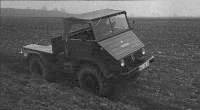คำตอบที่ 36
Mercedes-Benz U-411. So, as Henry Morgenthau had imagened it: an "original" 34hp UNIMOG U-411, towing a plowshear over a German field. The UNIMOGs look had not much changed from that of the 1948 Boehringer U-25s.
Photo: Mercedes-Benz Museum.
Seven months later the first prototype, equipped with a 4-cylinder, 1.7 liter (103 cu. in.) gasoline engine was complete. Still lacking in 1946 was a good quality diesel engine and the name for this new vehicle, which was neither a truck or a tractor. The name problem was soon solved by Hans Zabel, an engineer with the firm. He created an acronym from the name: UNIversal-MOtorGerไt (universal-power-unit) or UNIMOG.
The first UNIMOG saw intensive testing in 1947 and the results confirmed the concept. In 1948 a diesel engine became available, the 25 hp Daimler-Benz OM 636, which was also used in their 170D car. That same year the UNIMOG was shown at Frankfurt/Main for the first time. As a result of the show there was great enthusiasm which resulted in production plans. The UNIMOG team now searched for a new plant. In the autumn of 1948 they moved to the Werkzeugmaschinenfabrik Boehringer factory which became the new manufacturing plant for UNIMOG. In the following two years about 600 UNIMOGs (U 25) were produced. In 1951 Daimler-Benz (DB) started showing interest and the UNIMOG plant moved again to Gaggenau, where there is still the UNIMOG production line today. In May 1953 UNIMOG received the famous Mercedes star.
The first U 25 UNIMOG (wheel base 1720 mm (67 in.)) was already successful: it operated at speeds between 0.5 km/h (0.03 mph) in the lowest gear up to 52 km/h (32 mph) in high gear. It had an empty weight of 1780 kg (3924 lbs.) and maximum of 3150 kg (6944 lbs.) Not only were farmers and forestry workers fans of the UNIMOG, but the French army occupation forces in southwestern Germany ordered the first military UNIMOGs. In 1950-51 they purchased 400 of the model U 25.
The U 25s designation changed in 1953 to the U 401/402, depending on whether it was a short or long wheel base model. In 1956 the last 25 hp UNIMOG was delivered. Total production of this model numbered 16,250. It was followed by a similar looking model 411, available in 1720 mm (67 in.) wheel base and, from 1958, a 2120 mm (83.5 in.) wheel base. The U 411 was initially supplied with a 30 hp engine which was increased to 32 hp in 1959. From 1966 until the end of the U 411s production in 1974 they had a 34 hp diesel engine. In all, a total of 39,000 U 411 vehicles were made, some with a soft top and others with a steel cab. The German Bundeswehr also ordered some of them for use in their Gebirgsjไger (mountain troops) units.





